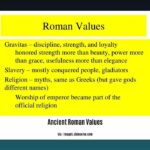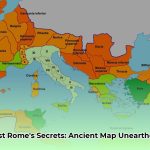Have you ever paused to consider the rich tapestry of history woven into your own last name? For citizens of ancient Rome, a family name, or nomen, was far more than a mere identifier; it served as a profound blueprint of identity, intricately revealing a family’s deep-rooted history, their distinct social standing, and even their ancestral origins. These ancient Roman surnames functioned as sophisticated codes, unlocking narratives of power, prestige, and the very fabric of daily life within the expansive Roman Empire. This comprehensive article delves into the captivating world of Roman family names, unraveling their hidden meanings and demonstrating their pervasive influence on Roman society. We will explore the distinctive Roman naming system, from its foundational elements to its imperial grandeur, touching upon the surnames of iconic figures like Caesar and Augustus. Prepare to journey back in time and uncover how a name could determine one’s fate in ancient Rome, potentially even illuminating a subtle connection to your own family’s past.
The Tripartite Code: Understanding Roman Naming Conventions
The method by which Romans, particularly freeborn citizens, identified themselves was considerably more intricate than the straightforward “first name, last name” structure prevalent today. Over centuries, from the early Republic through the Imperial period, this system evolved into a highly sophisticated and standardized tripartite designation known as the tria nomina. This comprehensive structure included:
- Praenomen: This served as the personal given name, akin to our modern first name. Used for individual identification within the family and among close acquaintances, the praenomen was typically chosen from a limited pool of around 15–20 common names (e.g., Lucius, Gaius, Marcus, Publius). Its abbreviation often appeared in inscriptions due to its commonality.
- Nomen: This crucial element was the family name, or clan name (nomen gentilicium), which denoted an individual’s lineage and their membership in a specific gens (a clan or extended family unit). This is what we primarily consider a Roman surname. The nomen was hereditary, passed down from father to child, and was the most significant indicator of Roman citizenship.
- Cognomen: Functioning as an additional surname, this often began as a descriptive nickname. It frequently served to distinguish different branches within a larger gens or to highlight a notable characteristic, achievement, or even a physical trait of an individual or a familial line (e.g., Cicero, meaning “chickpea,” or Brutus, meaning “dullard”). Over time, many cognomina also became hereditary. Some distinguished Romans even acquired a second cognomen, known as an agnomen, typically to commemorate a military victory or significant personal achievement.
This intricate naming system provided a robust framework for personal identity and social navigation, clearly defining an individual’s place within the complex hierarchy of ancient Roman society.
Unveiling the Roots: Origins and Meanings of Roman Surnames
The roots of many ancient Roman surnames were surprisingly grounded in the everyday realities of the time. They commonly derived from various facets of life, closely mirroring how common modern names like “Baker” or “Hill” became permanent family identifiers. Roman nomina and cognomina drew from diverse sources:
- Occupational Origins: Many names directly reflected an ancestor’s profession. For instance, Agricola (farmer), Figulus (potter), Tignarius (carpenter), or Mercator (merchant).
- Geographical Connections: Names could indicate a family’s place of origin or a region with which they were associated. Examples include Romanus (from Rome), Sabinus (from the Sabine region), or Tuscus (from Etruria).
- Physical Characteristics: Many cognomina began as descriptions of an individual’s notable physical traits. Rufus meant “red-haired,” Longus meant “tall,” Caecus meant “blind,” Calvus meant “bald,” and Strabo referred to someone with a squint. While seemingly unflattering, these simply served as distinguishing marks.
- Personal Attributes or Virtues: Some cognomina conveyed qualities or achievements. Felix meant “lucky” or “fortunate,” Magnus meant “great,” and Priscus meant “ancient” or “venerable.”
- Fauna and Flora: Names could also derive from animals or plants. Porcius (pig), Lupus (wolf), Corvinus (raven), Aries (ram), and Fabius (bean grower) illustrate this connection to the natural world.
- Divine or Mythological Associations: As seen with Julius, sometimes names hinted at legendary or divine ancestry, adding immense prestige. Other examples include Martius (of Mars, the god of war) or Aurelius (golden), often associated with auspiciousness.
This rich mosaic of origins made each Roman name a miniature historical record, conveying a wealth of information about its bearer and their lineage.
Names of Influence: Roman Surnames and Social Hierarchy
Possessing the full tria nomina was not a universal privilege but rather a hallmark predominantly associated with Roman male citizens who enjoyed a higher social standing. This practice underscored one’s established place and respectability within the social order of the Roman Republic and Empire. It inherently indicated belonging to a family with a recognized history and an esteemed position, signaling Roman citizenship and political influence.
- Patricians: Members of the oldest and most aristocratic families often had ancient, well-known nomina (e.g., Cornelius, Fabius, Valerius). Their names immediately signified their hereditary prestige and access to political and religious offices.
- Plebeians: While initially excluded from certain privileges, plebeian families eventually gained prominence. Many established their own gentes and developed their own distinctive nomina (e.g., Julius, Antonius, Claudius—though some plebeian lines later rose to imperial power).
- Freedmen (Liberti): Upon emancipation, a freed slave would typically adopt the praenomen and nomen of their former master, followed by their original slave name (or a shortened form) as their cognomen. For example, Marcus Tullius Tiro (Cicero’s freedman). This naming convention visibly marked their new legal status as Roman citizens but also highlighted their servile origin, indicating their position at the lower rung of citizen society.
- Women’s Names: Women generally did not use the praenomen (though exceptions existed for clarity). Instead, a woman was typically identified by her father’s nomen in the feminine form. For instance, a daughter of Lucius Cornelius Sulla would be Cornelia. If there were multiple daughters, they might be distinguished by numbers (Prima, Secunda, Tertia) or descriptive cognomina (e.g., Cornelia Major and Cornelia Minor). Upon marriage, a woman usually retained her father’s nomen, though she might sometimes adopt a cognomen derived from her husband’s family to signify the alliance without formally changing her lineage. This system overtly reflected the patriarchal structure of ancient Roman society, where a woman’s identity was largely defined through her male relatives.
The Imperial Legacy: Caesar, Augustus, and Beyond
The impact of iconic figures such as Julius Caesar and Caesar Augustus on Roman culture and political identity was monumental. Their nomina, particularly “Caesar” and “Augustus,” transcended mere appellations, evolving into profound symbols of imperial power and authority.
Following the assassination of Julius Caesar and the rise of his adopted son Octavian, who became Augustus, the cognomen “Caesar” became a powerful marker of dynastic succession and legitimacy. Subsequent emperors of the Julio-Claudian dynasty, such as Tiberius and Nero, adopted “Caesar” as part of their imperial title, solidifying its association with supreme executive power. Over time, “Caesar” was even used to designate the heir apparent to the throne, becoming a title of honor for younger members of the imperial family.
Similarly, the agnomen “Augustus,” bestowed upon Octavian by the Senate, meant “majestic,” “venerable,” or “exalted.” This honorific epithet became an integral part of the emperor’s official title, symbolizing his unique religious and political authority. Every subsequent Roman emperor adopted “Augustus” as a testament to their supreme authority and to link themselves to the success and stability of the Augustan age. These imperial Roman surnames became exclusively reserved for emperors and their immediate families, serving to solidify their supreme authority and clearly differentiate them from the general populace. They embodied the very essence of military might, administrative prowess, and divine favor, becoming the very cornerstones of the new imperial order.
The Fading and Enduring: Decline of the Roman Naming System
While the tria nomina system flourished for centuries, it began to decline in complexity and prevalence during the Late Roman Empire and the Early Middle Ages. Several factors contributed to this shift:
- Simplification: As the empire faced increasing political and economic instability, naming practices began to simplify. The cognomen, once a distinguishing mark, often merged with or superseded the nomen, and eventually, individuals might use only a single name.
- Christianization: With the rise of Christianity, religious names and personal names gained greater importance, gradually replacing the traditional Roman system. Surnames derived from biblical figures or saints became more common.
- Barbarian Invasions: The influx of various Germanic and other non-Roman populations into the empire brought different naming traditions, which further diluted the standardized Roman approach.
- Loss of Public Records: The administrative collapse and widespread destruction of records during the fall of the Western Roman Empire meant that the meticulous documentation necessary to maintain complex naming conventions was lost.
Despite its formal decline, the Roman naming system left an indelible mark on European naming conventions. The concept of a hereditary family name, though evolving significantly, owes much to the Roman nomen.
Echoes Through Time: Roman Surnames in the Modern World
The enduring legacy of the Roman naming system continues to profoundly influence modern surname practices across the globe. Numerous last names we encounter today can trace their distant ancestry back to these ancient Roman surnames, forging a tangible link to a civilization that flourished millennia ago. From common European family names to less obvious derivations, the Roman influence is palpable:
- Direct Descendants: Many Italian, Spanish, Portuguese, and French surnames are direct or slightly modified descendants of Roman names. For example, Giuliani (Italian) from Julius, Martínez (Spanish) from Martinus, or Valérie (French) from Valerius.
- Latin Roots: Even surnames that are not direct descendants often have Latin roots that were common in the Roman world. Think of names conveying professions (e.g., Faber for smith), locations, or personal qualities.
- Global Spread: Through colonial expansion and cultural exchange, names with Roman origins have spread worldwide, a testament to the vast reach and enduring impact of Rome itself.
It is truly remarkable to consider that your own last name might carry subtle echoes of Roman history within its syllables, connecting you to a vast and intricate past.
Unlocking Your Past: Tracing Potential Roman Ancestry
Dreaming of a direct lineage to the Roman Empire? While fascinating, definitively proving a direct genealogical connection to a specific Roman individual from antiquity remains exceptionally challenging. The primary hurdle lies in the significant scarcity of surviving historical records from that era. Time, numerous conflicts, and natural disasters have unfortunately led to the loss or destruction of countless ancient documents, especially those concerning non-noble families.
The Record Hurdle: Why Roman Records Are Scarce
Despite Roman record-keeping being advanced for its period, it was not primarily designed for comprehensive genealogical tracking across generations for the general populace. Census data (census), tax records (tabulae censoriae), and military diplomas (diplomata militaria) served governance and legal purposes more than individual posterity. These records rarely linked generations explicitly, and their survival is sporadic at best. Furthermore, the turbulent history of the Roman Empire, marked by invasions, economic decline, and its eventual fragmentation, resulted in the widespread destruction of invaluable administrative and personal records. Vast libraries and archives perished, making traditional genealogical research highly difficult for periods prior to the early medieval era.
However, this does not mean the pursuit of your potential Roman roots is futile. Surviving documents, even fragmented ones — such as legal tablets, gravestones, military discharge papers, and papyri — can still offer invaluable clues regarding geographical origins, occupations, and social statuses. The journey often involves meticulous investigation and interpretation of archaeological, epigraphic, and literary evidence.
Genetic Genealogy: A Modern Time Machine
Enters genetic genealogy, providing a powerful modern tool for exploring deep ancestral origins. While it cannot pinpoint a specific Roman ancestor, DNA testing can reveal broad ancestral origins and migration patterns that align with the historical footprint of the Roman Empire.
- Y-DNA (Paternal Lineage): If you are male, Y-chromosome DNA (Y-DNA) testing can trace your direct paternal line back thousands of years. Specific Y-DNA haplogroups (e.g., R1b, J2, E1b1b, G2a, I1) are prevalent in regions that constituted the heartlands and highly Romanized provinces of the empire (Italy, Spain, North Africa, parts of the Middle East, Roman Gaul, and Britannia). Identifying one of these haplogroups, especially coupled with a deep tree branch that matches patterns in former Roman territories, can suggest ancestral connections to populations that lived within the empire.
- Mitochondrial DNA (Maternal Lineage): Both males and females inherit mitochondrial DNA (mtDNA) from their mothers. mtDNA testing traces the direct maternal line. Haplogroups like H, U, K, T, and J are also found across former Roman territories, and their presence can indicate a maternal lineage stretching back to populations in those regions during Roman times.
- Autosomal DNA (Broader Connections): Autosomal DNA (atDNA) testing, offered by services like AncestryDNA and 23andMe, analyzes DNA inherited from all your recent ancestors. While its reach is only about 5-7 generations for specific matches, it provides “ethnicity estimates” or “population admixtures” that can indicate what percentage of your DNA originates from various regions of the world. A significant percentage of ancestry tracing back to Italy, Greece, or other heavily Romanized areas of Europe and North Africa suggests a shared ancestral connection within a broader historical timeframe. It’s important to remember that a 1% DNA match to a specific region doesn’t equate to direct descent from a Roman emperor but rather suggests a shared ancestral connection within a broader historical context. The reliability of DNA evidence is continuously improving, with new discoveries regularly refining our understanding of ancient migration and population movements.
Actionable Steps to Uncover Your Potential Roman Roots:
Uncovering potential Roman connections requires a multi-faceted approach. Here are actionable steps you can take:
- Start with DNA Testing: Utilize reputable services such as AncestryDNA, 23andMe, or MyHeritage DNA to gain insights into your ethnic and geographic origins. Pay close attention to “Italian,” “Greek,” “Sardinian,” “Iberian,” “North African,” and “Middle Eastern” components in your ethnicity estimates. Explore your Y-DNA and mtDNA
- Unearth ancient rome roads: Empire’s power and modern highway’s origin - August 15, 2025
- Discover geography of ancient Rome: Empire’s secrets revealed (2024 insights) - August 15, 2025
- Unveiling Ancient Roman Empire Geography: Power & Legacy Secrets - August 15, 2025

















1 thought on “Unlock Ancient Roman Surnames: Discover Origins & Social Impact Today”
Comments are closed.